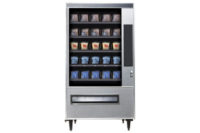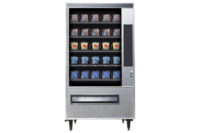Grainger added about 1,000 vending machines in the past year, and probably will add double that by the end of 2013, according to Ron Jadin, senior vice president and CFO.
Fastenal aims to have 30,000 new vending machines under contract by the end of 2013.
What’s behind the cresting wave of vending machines hitting U.S. workplaces?
Supply Pro, maker of SupplyLocker, SmartDrawer™, SupplyAgent point of use cabinet, and SupplyBay industrial vending systems, points out these reasons to implement what it calls “intelligent materials management”:
Reduce consumption
- Automation and accountability causes consumption to fall 20 – 30% on average — activating dispense limits have shown savings greater than 50% in usage and spend
Manpower reductions
- Fewer workers are left to manage and distribute supplies – automation is a controlled 24/7 solution
Quality assurance
- Do the fibers in cotton gloves cause quality failures on the assembly line? Then restrict access to the appropriate glove type
Housekeeping Initiatives
- Eliminate overflow of open bins and waste from workers taking bundles and leaving them throughout the work area
Ensure the right access to the right safety supplies
- The lightweight cotton glove is not appropriate for workers in the fabrication department? Then restrict access.
Standardization and purchasing initiatives
- Eliminate off-contract spending and unlimited versions of products (i.e. safety glasses: tinted, wrap-around, full face, colored, etc.)
Eliminate risk associated to safety equipment maintenance
- Never issue a lanyard out of calibration
Immediate access to information
Automated and on-demand cost reporting by user, product, department and job — or any other important data point
Identify users who have not taken necessary safety supplies and Typical results, according to SupplyPro:
- Reduce consumption on average 20-40%
- Eliminate abuse of items with “take home appeal”
- Reduce “ghost cribs” and hoarding of supplies
- Ability to produce audit reporting for SOX compliance
- Reduce injury incidents and surrounding costs
- Increase compliance and accountability
- 24/7 automated access to critical safety supplies
Common applications and safety items managed by SupplyPro:
- Gloves (washed and new)
- Safety glasses
- Head and face protection
- Aprons
- Goggles
- Vehicle keys
- Lanyards and fall protection
- Welding protection
- Sweatbands
- Hard hats
- Respirators
- Hearing protection
- Lockout / tagouts
- Vehicle key access
- Confined space equipment
- Medicines
- Safety vests
- Rain suits
- Electrician suits
According to an article in the April issue of ISHN magazine written by Ansell Protective Products, almost any consumable product can be vended — from work gloves and hard hats to drill bits, chemicals and respirators. Some vending machines include cabinets that allow for dispensation of larger items. Vending machine use in plants has more than doubled over the past few years, with companies across a range of industries reaping cost benefits.
Significant cost savings
As companies continue to operate in a tight economy, they are attracted to vending programs’ projected savings of 25 to 40 percent, which result from increased efficiency, reduced product usage and greater productivity.
Vending machines allow plants to control which PPE is available to individual employees and to track specific products and the quantity of products workers use. Workers generally employ an identification number, an access card or a scanner badge to obtain PPE and other vended products. The machine not only compiles reports on product usage but it can be programmed to dispense only the product an individual worker needs — and in the appropriate size and quantity.
PPE and other products should never be vended without instructing individual workers about each product’s intended use and performance advantages. If a vending machine is not programmed to provide a worker a specific product, the worker must be educated about what product to select. This type of education will reduce the likelihood of a worker who constantly handles sharp instruments, for example, selecting a general purpose glove rather than a cut protective product.


